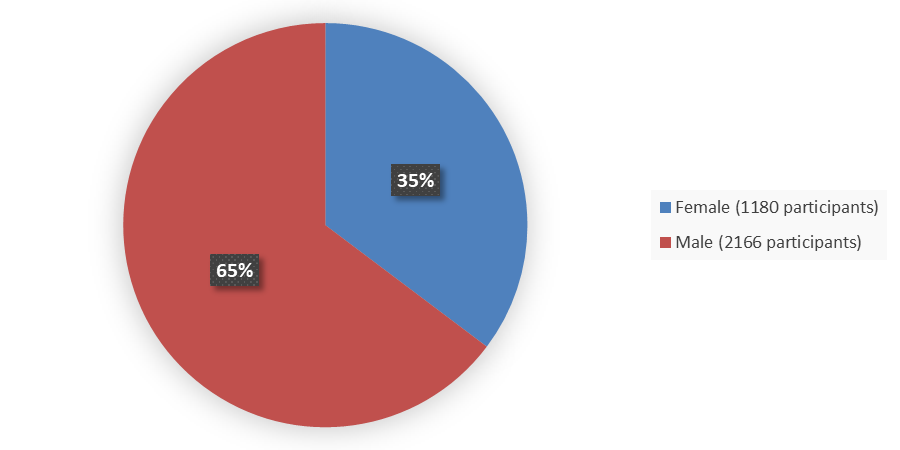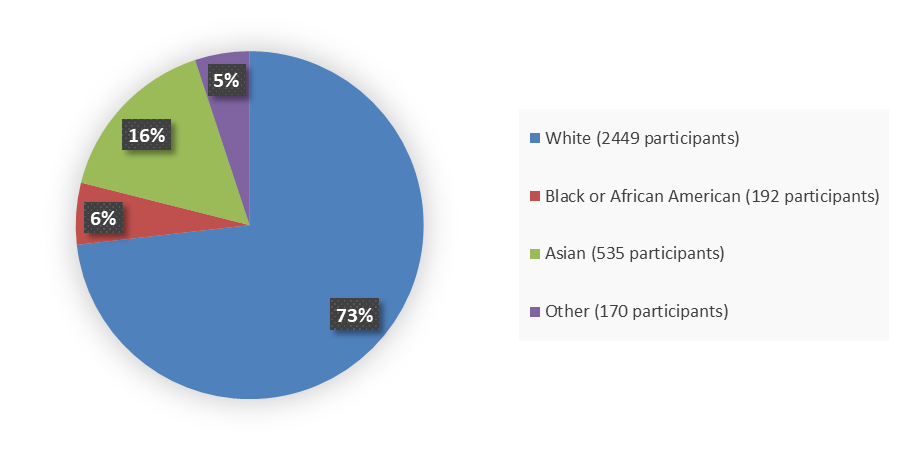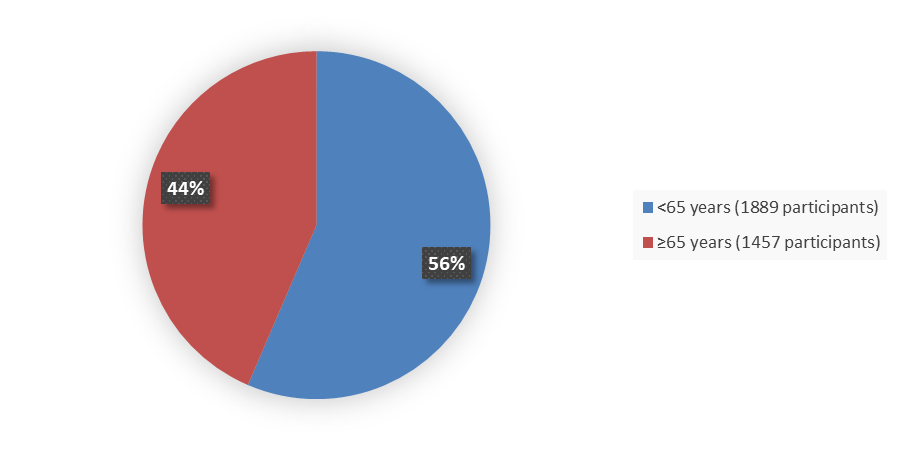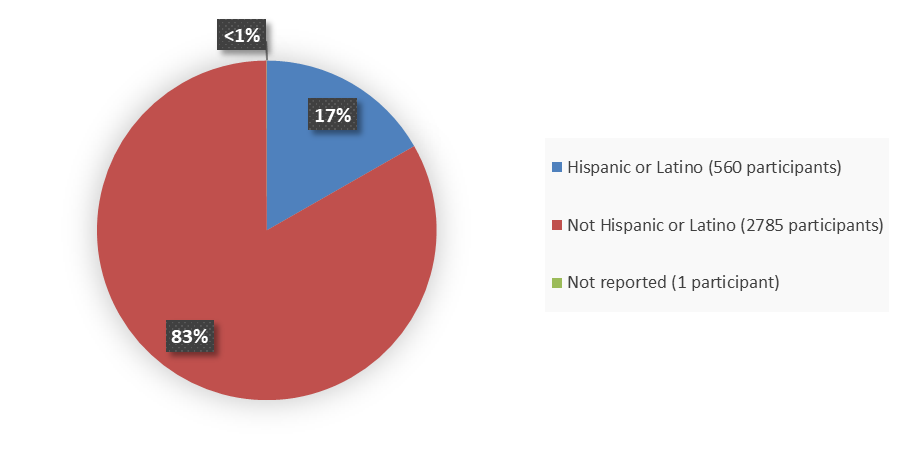Drug Trials Snapshots: BRENZAVVY
HOW TO USE THIS SNAPSHOT
The information provided in Snapshots highlights who participated in the key clinical trials that supported the original FDA approval of this drug, and whether there were differences among sex, race, age, and ethnic groups. The “MORE INFO” bar shows more detailed, technical content for each section. The Snapshot is intended as one tool for consumers to use when discussing the risks and benefits of the drugs.
LIMITATIONS OF THIS SNAPSHOT
Do not rely on Snapshots to make decisions regarding medical care. Always speak to your healthcare provider about the benefits and risks of a drug.
Some of the information in this Snapshot is for presentation purposes and does not represent the approved conditions of use of this drug. Refer to the BRENZAVVY Prescribing Information for all the approved conditions of use of this drug (e.g., indication(s), population(s), dosing regimen(s), safety information).
Snapshots are limited to the information available at the time of the original approval of the drug and do not provide information on who participated in clinical trials that supported later approvals for additional uses of the drug (if applicable).
BRENZAVVY (bexagliflozin)
(bren-ZA-vee)
TheracosBio
Approval date: January 20, 2023
DRUG TRIALS SNAPSHOT SUMMARY:
What is the drug for?
BRENZAVVY is a medicine that improves blood sugar control in adults with type 2 diabetes when used in addition to diet and exercise.
How is this drug used?
BRENZAVVY is a tablet that is taken by mouth once daily in the morning.
Who participated in the clinical trials?
The FDA approved BRENZAVVY based on evidence from nine clinical trials that enrolled 4,462 adults (2,578 of these patients received BRENZAVVY). The nine trials were conducted at 428 sites in 16 countries including the United States, Mexico, Colombia, Japan, Czech Republic, Poland, Spain, Hungary, France, Canada, Netherlands, Denmark, South Korea, Taiwan, Russia, and Germany. All nine trials were used to assess safety and six of these trials (enrolling 3,346 patients of the 4,462 patients) were used to assess the efficacy of BRENZAVVY.
How were the trials designed?
The efficacy of BRENZAVVY was evaluated in six clinical trials, while the safety of BRENZAVVY was evaluated in nine clinical trials of adults with type 2 diabetes whose blood sugar was not well controlled. All patients were required to follow diet and exercise recommendations, but the trials differed with respect to which other drugs patients were allowed to use for diabetes treatment.
In four trials, patients were randomly assigned to receive either BRENZAVVY or placebo by mouth once daily. In two trials, they received either BRENZAVVY or a different diabetes medicine. Neither the patients nor the healthcare providers knew which treatment patients received until after the trial was completed.
The benefit of BRENZAVVY was evaluated by the change in hemoglobin A1c (HbA1c) between the BRENZAVVY and the comparator (either placebo or another diabetes medicine) at the end of the treatment period.
How were the trials designed?
The efficacy of BRENZAVVY alone and in combination with metformin was evaluated in six randomized, double-blind, multi-center, controlled phase 3 clinical trials of adults with inadequately controlled type 2 diabetes.
The designs of the six trials for the efficacy were as follows:
- Trial 1: Randomized, double-blind, placebo-controlled 24-week trial in adults not on any other drug to treat diabetes (NCT02715258).
- Trial 2: Randomized, double-blind, placebo-controlled 24-week trial in adults receiving metformin (NCT03259789).
- Trial 3: Randomized double-blind active-controlled 60-week noninferiority trial comparing BRENZAVVY to glimepiride in adults already receiving metformin (NCT02769481).
- Trial 4: Randomized, double-blind, active-controlled 24-week noninferiority trial comparing BRENZAVVY to sitagliptin in adults already receiving metformin (NCT03115112).
- Trial 5: Randomized, double-blind, placebo-controlled 24-week trial in adults with moderate renal impairment receiving standard of care therapy for type 2 diabetes (NCT02836873).
- Trial 6: Randomized, double-blind, placebo-controlled trial in adults with established or increased risk for cardiovascular disease receiving standard of care therapy for type 2 diabetes (NCT02558296). The ability of BRENZAVVY to lower blood glucose was evaluated after 24 weeks of treatment, but participants remained enrolled and blinded to treatment for a minimum of 52 weeks to evaluate the longer-term safety of BRENZAVVY (average treatment duration 2.4 years).
WHO WAS IN THE CLINICAL TRIALS?
Figure 1 summarizes how many females and males were enrolled in the combined six clinical trials used to evaluate the efficacy of BRENZAVVY.
Figure 1. Baseline Demographics of Six Global Efficacy Trials by Sex
Source: Adapted from FDA Review
Figure 2 summarizes how many participants by race were enrolled in the combined six clinical trials used to evaluate the efficacy of BRENZAVVY.
Figure 2. Baseline Demographics by Race
Source: Adapted from FDA Review
Figure 3 summarizes how many participants by age were enrolled in the combined six clinical trials used to evaluate the efficacy of BRENZAVVY.
Figure 3. Baseline Demographics by Age
Source: Adapted from FDA Review
Figure 4 summarizes how many participants by ethnicity were enrolled in the combined six clinical trials used to evaluate the efficacy of BRENZAVVY.
Figure 4. Baseline Demographics by Ethnicity
Source: Adapted from FDA Review
Who participated in the trials?
Table 1. Demographics, Efficacy Population
| Demographic | Trial 1 N=207 n (%) |
Trial 2 N=317 n (%) |
Trial 3 N=426 n (%) |
Trial 4 N=384 n (%) |
Trial 5 N=312 n (%) |
Trial 6 N=1700 n (%) |
|---|---|---|---|---|---|---|
| Sex | ||||||
| Female | 107 (52) | 123 (39) | 178 (42) | 138 (36) | 116 (37) | 518 (30) |
| Male | 100 (48) | 194 (61) | 248 (58) | 246 (64) | 196 (63) | 1182 (70) |
| Age, years | ||||||
| <65 | 170 (82) | 251 (79) | 296 (69) | 259 (67) | 75 (24) | 838 (49) |
| ≥65 | 37 (18) | 66 (21) | 130 (31) | 125 (33) | 237 (76) | 862 (51) |
| Race | ||||||
| White | 154 (74) | 99 (31) | 402 (94) | 314 (82) | 171 (55) | 1309 (77) |
| Black of African American | 31 (15) | 55 (17) | 9 (2) | 8 (2) | 15 (5) | 74 (4) |
| Asian | 20 (10) | 157 (50) | 13 (3) | 62 (16) | 120 (38) | 163 (10) |
| Other | 2 (1) | 6 (2) | 2 (1) | 0 (0) | 6 (2) | 154 (9) |
| Ethnicity | ||||||
| Not Hispanic or Latino | 100 (48) | 250 (79) | 333 (78) | 374 (97) | 287 (92) | 1441 (85) |
| Hispanic or Latino | 107 (52) | 67 (21) | 93 (22) | 10 (3) | 24 (8) | 259 (15) |
| Not reported | 0 | 0 | 0 | 0 | 1 (<1) | 0 |
| Country of participation | ||||||
| United States | 174 (84) | 166 (52) | 128 (30) | 36 (9) | 103 (33) | 602 (35) |
| Rest of the world | 33 (16) | 151 (48) | 298 (70) | 348 (91) | 209 (67) | 1098 (65) |
Source: Adapted from FDA Review
What are the benefits of this drug?
In adults with type 2 diabetes treatment with BRENZAVVY can lower HbA1c. HbA1c is a measure of blood sugar control over the last 8 to 12 weeks.
What are the benefits of this drug (results of trials used to assess efficacy)?
The FDA considered the results of six global, randomized clinical trials to evaluate the efficacy of BRENZAVVY in the treatment of adults with type 2 diabetes. In these trials, BRENZAVVY was used as monotherapy or in combination with other diabetes medicines. The efficacy of BRENZAVVY was compared to placebo and to two different diabetes medicines (glimepiride and sitagliptin). The primary efficacy endpoint in each trial was change in HbA1c from baseline. The results of each trial are presented in Table 2.
Table 2. Impact on HbA1c (%) From Baseline in Six Global Clinical Trialsa
| Trial | Comparator | Nb | HbA1c Change From Baselinec 95% Confidence Interval |
|---|---|---|---|
| 1 | Placebo | 207 | -0.4 (-0.6, -0.1) |
| 2 | Placebo | 317 | -0.5 (-0.7, -0.3) |
| 3 | Glimepiride | 426 | -0.0 (-0.2, 0.1) |
| 4 | Sitagliptin | 384 | 0.1 (-0.1, 0.2) |
| 5 | Placebo | 312 | -0.3 (-0.4, -0.1) |
| 6 | Placebo | 1700 | -0.4 (-0.5, -0.4) |
Source: Adapted from BRENZAVVY Prescribing Information
a In the four placebo-controlled studies, BRENZAVVY was used as monotherapy in Trial 1, in combination with metformin in Trial 2, as add-on to standard of care therapy in adults with moderate renal impairment in Trial 5, and in patients with increased risk for major adverse cardiovascular events in Trial 6.
b Intention to treat population. All randomized patients.
c HbA1c change from baseline is comparator-adjusted.
Were there any differences in how well the drug worked in clinical trials among sex, race, and age?
- Sex: BRENZAVVY worked similarly in males and females.
- Race: BRENZAVVY worked similarly in Asians, Black or African Americans, and Whites. The number of patients of other races was limited; therefore, differences in response among other races could not be determined.
- Age: BRENZAVVY worked similarly in adults younger and older than 65 years of age.
Were there any differences in how well the drug worked in clinical trials among sex, race, and age groups?
Differences between BRENZAVVY and the comparator for HbA1c percent change are presented according to sex, race and age in Table 3, Table 4, and Table 5, respectively.
Table 3. Impact on HbA1c Change From Baseline (Comparator-Adjusted) With 95% Credible Intervals, by Sexa
| Trial (Comparator) Subgroup |
BRENZAVVY N |
Comparator N |
HbA1c Change From Baselineb 95% Credible Interval |
|---|---|---|---|
| Trial 1 (placebo) | |||
| Female | 72 | 35 | -0.3 (-0.7, 0.1) |
| Male | 66 | 34 | -0.5 (-0.8, -0.2) |
| Trial 2 (placebo) | |||
| Female | 58 | 65 | -0.4 (-0.7, -0.1) |
| Male | 100 | 94 | -0.5 (-0.7, -0.2) |
| Trial 3 (glimepiride) | |||
| Female | 95 | 83 | 0.0 (-0.2, 0.3) |
| Male | 118 | 130 | -0.1 (-0.3, 0.1) |
| Trial 4 (sitagliptin) | |||
| Female | 71 | 67 | 0.0 (-0.2, 0.2) |
| Male | 120 | 126 | 0.1 (-0.1, 0.2) |
| Trial 5 (placebo) | |||
| Female | 65 | 51 | -0.3 (-0.5, -0.1) |
| Male | 92 | 104 | -0.3 (-0.5, -0.1) |
| Trial 6 (placebo) | |||
| Female | 341 | 177 | -0.4 (-0.6, -0.3) |
| Male | 792 | 390 | -0.5 (-0.6, -0.4) |
Source: Adapted from FDA Review
a Estimates and credible intervals for treatment effect include relevance of outcomes from other subgroups.
b HbA1c change from baseline is comparator-adjusted.
Table 4. Impact on HbA1c Change From Baseline (Comparator-Adjusted) With 95% Credible Intervals, by Racea
| Trial (Comparator) Raceb |
BRENZAVVY N |
Comparator N |
HbA1c Change From Baselinec 95% Credible Interval |
|---|---|---|---|
| Trial 1 (placebo) | |||
| White | 96 | 58 | -0.4 (-0.6, -0.1) |
| Black or African American | 25 | 6 | -0.3 (-0.8, 0.1) |
| Asian | 15 | 5 | -0.4 (-1.0, 0.1) |
| Other races | 2 | 0 | Not estimabled |
| Trial 2 (placebo) | |||
| White | 51 | 48 | -0.5 (-0.8, -0.1) |
| Black or African American | 26 | 29 | -0.4 (-0.8, -0.0) |
| Asian | 78 | 79 | -0.5 (-0.7, -0.4) |
| Other races | 3 | 3 | Not estimabled |
| Trial 3 (glimepiride) | |||
| White | 198 | 204 | -0.1 (-0.2, 0.1) |
| Asian | 9 | 4 | 0.1 (-0.6, 0.7) |
| Black or African American | 5 | 4 | -0.0 (-0.7, 0.6) |
| Other races | 1 | 1 | Not estimabled |
| Trial 4 (sitagliptin) | |||
| Whites | 158 | 156 | 0.1 (-0.1, 0.2) |
| Asian | 27 | 35 | 0.0 (-0.2, 0.2) |
| Black or African American | 6 | 2 | Not estimabled |
| Trial 5 (placebo) | |||
| White | 83 | 88 | -0.3 (-0.5, -0.1) |
| Black or African American | 9 | 6 | -0.3 (-0.6, 0.1) |
| Asian | 61 | 59 | -0.3 (-0.5, -0.1) |
| Other races | 4 | 2 | Not estimabled |
| Trial 6 (placebo) | |||
| White | 879 | 430 | -0.4 (-0.5, -0.3) |
| Black or African American | 46 | 28 | -0.6 (-0.9, -0.2) |
| Asian | 108 | 55 | -0.5 (-0.8, -0.3) |
| Other races | 100 | 54 | -0.6 (-0.9, -0.3) |
Source: Adapted from FDA Review
a Estimates and credible intervals for treatment effect include relevance of outcomes from other subgroups.
b Other races subgroup includes American Indian or Alaska Native, Native Hawaiian or other Pacific Islander, and multiple races.
c HbA1c change from baseline is comparator-adjusted.
d Not estimable for comparator-adjusted HbA1c change from baseline because sample size is too small.
Table 5. Impact on HbA1c Change From Baseline (Comparator-Adjusted) With 95% Credible Intervals, by Agea
| Trial (Comparator) Age, Years |
BRENZAVVY N |
Comparator N |
HbA1c Change From Baselineb 95% Credible Interval |
|---|---|---|---|
| Trial 1 (placebo) | |||
| <65 | 112 | 58 | -0.4 (-0.6, -0.1) |
| ≥65 | 26 | 11 | -0.4 (-0.8, 0.0) |
| Trial 2 (placebo) | |||
| <65 | 127 | 124 | -0.5 (-0.8, -0.3) |
| ≥65 | 31 | 35 | -0.2 (-0.6, 0.1) |
| Trial 3 (glimepiride) | |||
| <65 | 150 | 146 | -0.0 (-0.2, 0.2) |
| ≥65 | 63 | 67 | 0.0 (-0.2, 0.2) |
| Trial 4 (sitagliptin) | |||
| <65 | 130 | 129 | 0.1 (-0.1, 0.2) |
| ≥65 | 61 | 64 | 0.0 (-0.2, 0.3) |
| Trial 5 (placebo) | |||
| <65 | 38 | 37 | -0.2 (-0.5, 0.1) |
| ≥65 | 119 | 118 | -0.3 (-0.5, -0.1) |
| Trial 6 (placebo) | |||
| <65 | 562 | 276 | -0.6 (-0.7, -0.4) |
| ≥65 | 571 | 291 | -0.3 (-0.5, -0.2) |
Source: Adapted from FDA Review
a Estimates and credible intervals for treatment effect include relevance of outcomes from other subgroups.
b HbA1c change from baseline is comparator-adjusted
What are the possible side effects?
BRENZAVVY may cause ketoacidosis, a serious, potentially life-threatening complication that occurs when the body produces high levels of acids in the blood. BRENZAVVY may also cause serious side effects such as an increased incidence for surgery to remove parts of the legs or feet, decreases in blood pressure due to excessive loss of water and sodium from the body, serious infections in the genital region (Fournier’s gangrene), very low blood sugar levels when used in combination with insulin or medications that increase insulin in the body, and serious urinary tract infections. Serious urinary tract infections can spread to the kidneys (pyelonephritis) or cause a serious, potentially life-threatening blood infection (urosepsis).
The most common side effects with BRENZAVVY are genital yeast infections, urinary tract infections, and increased urination.
What are the possible side effects (results of trials used to assess safety)?
Table 6 summarizes common adverse reactions from three placebo-controlled trials. BRENZAVVY was used alone in two trials and in combination with metformin in the other trial.
Table 6. Adverse Reactions Reported in ≥5% of BRENZAVVY-Treated Patients With Type 2 Diabetes Mellitus in Three Placebo-Controlled Trials
| Adverse Reaction | Placebo N=300 % |
BRENZAVVY N=372 % |
|---|---|---|
| Increased urination | 3 | 7 |
| Urinary tract infection | 4 | 6 |
| Female genital mycotic infection (yeast infection of the female genitals) | 0 | 6 |
| Thirst | 2 | 3 |
| Vaginal pruritus (itch) | 0 | 3 |
| Male genital mycotic infection (yeast infection of the male genitals) | 1 | 2 |
| Hypoglycemia (blood sugar that is too low) | 1 | 2 |
Source: BRENZAVVY Prescribing Information
Note: Percentages reflect the number of patients who reported at least one occurrence of the adverse reaction.
Were there any differences in side effects among sex, race and age?
- Sex: More genital yeast infections were seen in females taking BRENZAVVY compared to males. In clinical trials, all patients treated with BRENZAVVY had more genital yeast infections compared to patients given placebo.
- Race: The occurrence of side effects was similar between American Indian or Alaska Native, Asian, Black or African American, and White patients.
- Age: The occurrence of side effects was similar between adults younger and older than 65 years of age.
Were there any differences in side effects of the clinical trials among sex, race, and age groups?
The frequency of genital mycotic (yeast) infection adverse reactions in the three placebo-controlled trials by sex, age, and race are shown in Table 7.
Table 7. Frequency of Genital Mycotic (Yeast) Infection Adverse Reactions in Placebo-Controlled Trials by Sex, Race, and Age
| Demographic | Placebo N=300 n/Ns (%) |
BRENZAVVY N=372 n/Ns (%) |
|---|---|---|
| Sex | ||
| Female | 0/130 (0) | 9/156 (6) |
| Male | 2/170 (1) | 5/216 (2) |
| Race | ||
| Other | 0/3 (0) | 0/6 (0) |
| Asian | 1/121 (1) | 0/134 (0) |
| Black or African American | 0/43 (0) | 2/59 (3) |
| White | 2/133 (2) | 11/173 (6) |
| Age group, years | ||
| 18 to 64 | 2/231 (1) | 14/228 (6) |
| ≥65 | 0/69 (0) | 0/84 (0) |
Source: Adapted from FDA Review
Abbreviations: N, number of patients in treatment arm; n, number of patients meeting criteria; Ns, total number of patients for each specific subgroup and were assigned to that specific arm
GLOSSARY
CLINICAL TRIAL: Voluntary research studies conducted in people and designed to answer specific questions about the safety or effectiveness of drugs, vaccines, other therapies, or new ways of using existing treatments.
COMPARATOR: A previously available treatment or placebo used in clinical trials that is compared to the actual drug being tested.
EFFICACY: How well the drug achieves the desired response when it is taken as described in a controlled clinical setting, such as during a clinical trial.
PLACEBO: An inactive substance or “sugar pill” that looks the same as, and is given the same way as, an active drug or treatment being tested. The effects of the active drug or treatment are compared to the effects of the placebo.
SUBGROUP: A subset of the population studied in a clinical trial. Demographic subsets include sex, race, and age groups.




